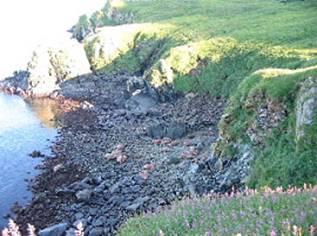
I've added a new link button "Live Walrus," that you are going to want to check out.
It takes you to the Alaska Sealife Center's live camera-satellite uplink feed of a Pacific walrus haulout on Round Island.
This video stream is brought to you courtesy of the U.S. Fish and Wildlife Service, Alaska Coastal Conservation Grant Program, Pacific Walrus Conservation Fund, National Park Service, National Natural Landmark program, Alaska Sealife Center, National Fish and Wildlife Foundation, and the Alaska Department of Fish and Game.
Monitoring population levels and conducting research on Pacific walrus is difficult due to their pelagic habits and the remote locations of their haulout sites. Monitoring the use of their terrestrial haulouts can provide an index to population changes; however, due to large fluctuations in haulout use, near constant monitoring is required to account for variability. Using onsite personnel to provide this level of constant monitoring is time-intensive and expensive resulting in an incomplete picture of the use of haulouts.
The stream sponsors find that efforts to promote education and conservation programs on a little understood species, or a species rarely encountered by the general public, are usually much more effective when the species is more accessible to public viewing. In North America, the Pacific walrus only inhabits the remote areas of the Bering and Chukchi seas. Only those people that live in the remote villages of this region, and the few visitors that venture to the isolated haulouts, are privileged enough to observe walrus firsthand. On smell the walrus firsthand. It is my understanding that these haulouts carry a very distinct urine odor.
Those lucky few have created an Eskimo Walrus Commission (EWC) which encourages the self regulation of walrus hunting and management of walrus stock by Alaska Natives who use and need walrus to survive. Created in 1978 by Kawarak of Nome, the EWC represents Alaska's coastal communities. Initially formed as a consortium of Native hunters, EWC is a recognized statewide entity working on resource co-management issues on behalf of Alaska Natives as it continues to be an essential cultural, natural, and subsistence resource to the Alaskan Yupik and Inupiaq communities. Walrus is a primary resource of food for Alaska Natives, and hunt byproducts are used to produce handicrafts and artwork.
EWC works with the Bristol Bay Native Association's Qayassiq Walrus Commission for the monitoring os subsidence walrus hunts at the featured Round Island, and sponsors a summer youth internship program for high school students interested in biology and natural resources.
Through a cooperative agreement between the US and Russian governments, EWC also works with the Chukotkan Native coastal communities who participate in the harvest, conservation, and sound management of the Pacific walrus.
In 1972, the Marine Mammals Protection Act (MMPA) set a moratorium on taking (hunting, capturing, or killing) walrus in US waters. However, Alaska Natives were granted an exemption, allowing them to harvest marine mammals for traditional subsistence purposed.
A cooperative agreement between the US Fish & Wildlife Service and EWC was developed in 1997 to encourage subsistence hunters participation in conserving and managing walrus stocks in the coastal communities. Together they conduct biannual meetings of commission members who represent 18 communities; monitor subsistence walrus hunts on Round Island; collect detailed walrus harvest data and biological samples; record walrus harvest data through the federally mandated marking, tagging, reporting program; gather culture-based traditional knowledge; and work with communities to become more proactive in 'co-management' of the walrus population.
EWC is joined with other Alaska Native co-management organizations, such as the Nanuuq Commission, to form the Indigenous Peoples' Council for Marine Mammals (IPCoMM). Organized in 1991, IPCoMM is a statewide body comprised of 15 Native Marine Mammal Commissions and Councils working together to enhance coordination of statewide marine mammal issues.
Alaska member communities include Barrow, Brevig Mission, Clarks Point, Gambell, Kivalina, King Island, Kotzebue, Kwigillingok, Little Diomede, Mekoryuk, Nome, Point Hope, Savoonga, Shishmaref, Stebbins, Unalakleet, Wainwright, and Wales.
For more information contact the Eskimo Walrus commission at ewc.pd@kawerak.org.
No comments:
Post a Comment